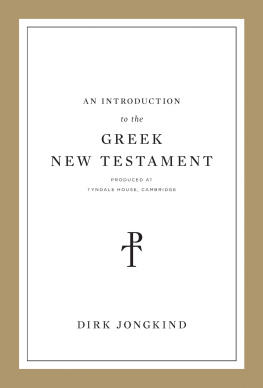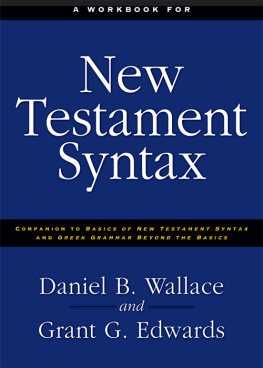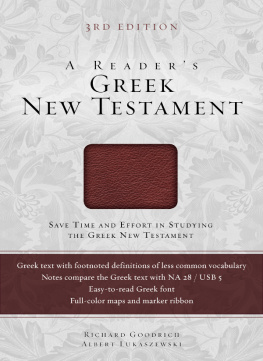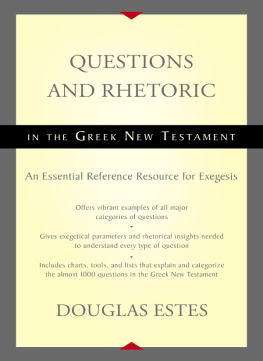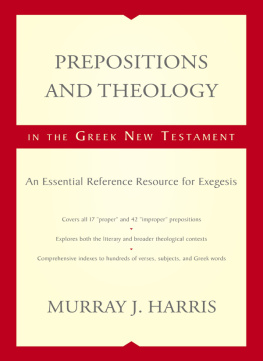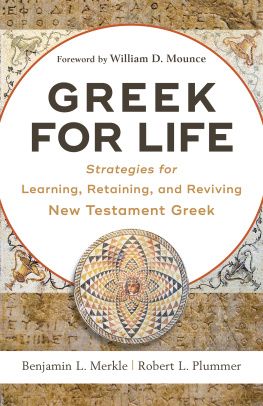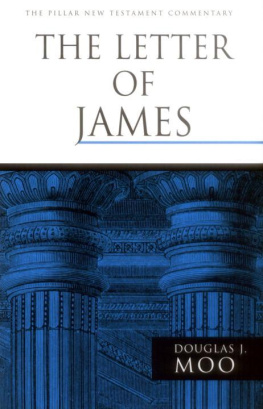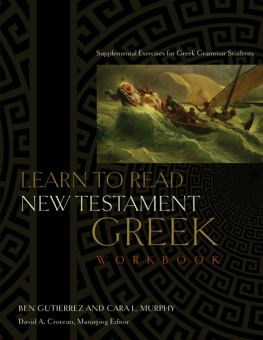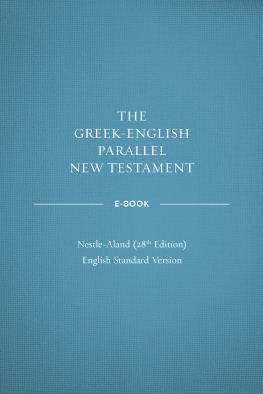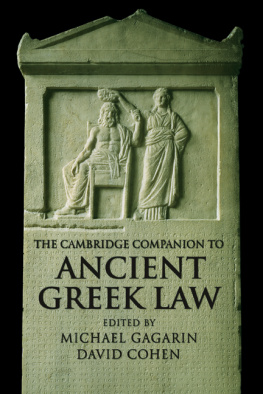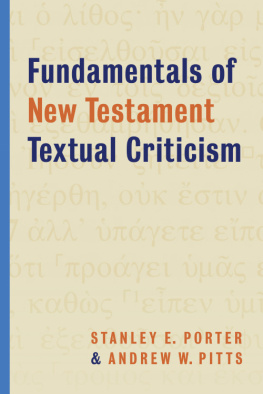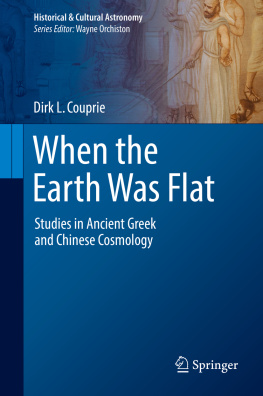Dirk Jongkind - An Introduction to the Greek New Testament, Produced at Tyndale House, Cambridge
Here you can read online Dirk Jongkind - An Introduction to the Greek New Testament, Produced at Tyndale House, Cambridge full text of the book (entire story) in english for free. Download pdf and epub, get meaning, cover and reviews about this ebook. year: 2019, publisher: Crossway, genre: Religion. Description of the work, (preface) as well as reviews are available. Best literature library LitArk.com created for fans of good reading and offers a wide selection of genres:
Romance novel
Science fiction
Adventure
Detective
Science
History
Home and family
Prose
Art
Politics
Computer
Non-fiction
Religion
Business
Children
Humor
Choose a favorite category and find really read worthwhile books. Enjoy immersion in the world of imagination, feel the emotions of the characters or learn something new for yourself, make an fascinating discovery.
- Book:An Introduction to the Greek New Testament, Produced at Tyndale House, Cambridge
- Author:
- Publisher:Crossway
- Genre:
- Year:2019
- Rating:5 / 5
- Favourites:Add to favourites
- Your mark:
- 100
- 1
- 2
- 3
- 4
- 5
An Introduction to the Greek New Testament, Produced at Tyndale House, Cambridge: summary, description and annotation
We offer to read an annotation, description, summary or preface (depends on what the author of the book "An Introduction to the Greek New Testament, Produced at Tyndale House, Cambridge" wrote himself). If you haven't found the necessary information about the book — write in the comments, we will try to find it.
Dirk Jongkind: author's other books
Who wrote An Introduction to the Greek New Testament, Produced at Tyndale House, Cambridge? Find out the surname, the name of the author of the book and a list of all author's works by series.
An Introduction to the Greek New Testament, Produced at Tyndale House, Cambridge — read online for free the complete book (whole text) full work
Below is the text of the book, divided by pages. System saving the place of the last page read, allows you to conveniently read the book "An Introduction to the Greek New Testament, Produced at Tyndale House, Cambridge" online for free, without having to search again every time where you left off. Put a bookmark, and you can go to the page where you finished reading at any time.
Font size:
Interval:
Bookmark:
In chapter 2, we looked at ways in which the Tyndale House Edition is different from other editions, and we examined some of its visually striking features. In the end, though, most of us are primarily interested in the actual words on the page. How do we decide what words to print when manuscripts differ from one another? For most of the approximately 135,000 words of the New Testament, no decision has to be madeeither because there is no variation or because the variation is found only in a single manuscript, in a group of relatively unimportant manuscripts, or in a subset of late manuscripts. For those places where decisions are necessary, we need criteria to help us. In this chapter, we explore the criteria and process for making these decisions.
External Evidence, Copying, and Internal Evidence
Four Areas of Information
In the Tyndale House Edition , the majority of the textual decisions are informed by four factors.
Distribution of the Evidence
The evidence is formed by the readings of the manuscripts, and they come from different contexts and different centuries. It is important to track which manuscripts have which reading, and if and when a reading is corrected. If a reading is found predominantly in earlier manuscripts and not in later ones, the development of the language or the liturgical use may be a factor in explaining how one reading developed out of another. Late manuscripts can contain variant readings that are much older than the date of these manuscripts. Most copies, however, were made to serve the contemporary reader, who was interested in the correct text according to current practice.
The evidence found in Greek manuscripts is not the only relevant information. It is useful to see how various translations that were made in the early centuries have dealt with the text (versional evidence). And where church fathers addressed the textual problem, they offer an additional piece of valuable information (though frequently church fathers tended to copy one another without providing us with an independent discussion). The Greek manuscripts, however, are key. The evidence from the versions and the fathers is of much less weight and mainly serves to confirm the text or to put question marks on variant readings.
Knowledge of the Individual Manuscripts
Manuscripts have their own characteristics and individual character, and this is especially true for the earlier manuscripts. Some of these characteristics may have to do with the scribe who copied the manuscript. Others are an accumulation of inherited features. It is important, though, to be aware of the particular tendencies of a manuscript, since a manuscript may be poor in spelling or in its treatment of word order but nevertheless contain many ancient readings. Beyond this, manuscripts can change character from book to book, or sometimes even within a book, as we saw above with W(032).
Knowledge of Groupings of Manuscripts
It is not just individual manuscripts that can have their own character; groups of manuscripts have their own tendencies as well. For example, the later Byzantine text is formed by many near -i dentical manuscripts from the early and late Middle Ages. In these, the influence of church liturgy is clearly visible. The Byzantine text also tends to be more consistent in the details of grammar and spelling than the original authors were.
Knowledge of Scribal Behavior
In general, scribes copied the text in front of them accurately. But when they made errors, such can be explained often by simple scribal mechanisms, many of which are observable in our own day -t o -d ay reading or writing. The reasons why we misread a sentence are similar to why a copyist misreads the text. And everyone who writes a lot knows about the strange errors we can produce. Similar -s ounding words creep in ( well confused with will ); our thoughts start wandering, and we insert these free associations into the text; and at the end of long sentences, we may have forgotten how we even started. All these tendencies have produced textual variants.
A much -q uoted text -c ritical rule is this: The more difficult reading is to be preferred to the easy reading ( lectio difficilior potior , literally, The more difficult reading is the stronger one). This might be a helpful rule if only text critics could agree on what makes a reading difficult. Is it a theological difficulty, or an exegetical one, or a grammatical one? If we would apply this metarule strictly, it could result in an edition giving a collection of near -n onsense readings. Still, the rule points toward the need to weigh probabilities. It helps answer questions such as, Is it more likely that a scribe introduced a wording that harmonizes one of the Gospels with the parallel account or a wording that makes them more different? Is it more likely that, during hours of copying, scribes gravitated toward the standard, unmarked word order or to a more emphatic one?
At times, it may seem as if the decisive argument changes from variant to variant. Sometimes the manuscript evidence is sufficient; at other times, the same evidence is rejected. So how is this theoretical model applied in practice?
A Balancing Act
When we start thinking about a variant unit, the first question is always this: How is the evidence distributed over the various alternative readings? The 19:34 (either by mistaken memory or a marginal note). Later we will see more instances where influence from other parts of the New Testament has affected the wording of manuscripts. To be clear, early manuscripts are important, but by no means are they free from error. The first principle can be summed up in this question: Is there a good reason not to print the oldest attested text?
The second principle is that, in general, variants have simple causes. Variants came into being because the copyist made an unintentional error, which is almost inevitable in the process of copying a text. In the wider world of ancient manuscript culture, we have many examples of highly accurate copies. But in the turbulent context of the early Christian church, not all copies were written according to the same exacting standards. A typical error was to add words or phrases from the immediate context. So in John 5:12 many manuscripts read (take up your mat), and on the surface this sounds absolutely fine. Yet the earliest witnesses leave out . This is the better reading since, in light of 5:8, 9, and 10, it is easily understood how the standard expression was simply repeated while still fresh in the scribes memory.
A practical outworking of this principle is that once we have a perfectly legitimate, simple explanation of a variant, there is no further need to go into possible exegetical or theological motivations for the scribal change. That would amount to methodological overkill.
As seen in the above examples, we take variants one at a time. If a manuscript is correct at one place (or at many places), there is no guarantee that it will be correct at the next. This leads to the inelegant situation that an edition made according to these principles gives us a text that is not a word -f or -w ord replica of any individual manuscript but is, according to the assessment of the editors, the closest possible approximation of the oldest recoverable text. It is an eclectic edition. Of course, we could print the text exactly as found in an individual manuscript, but that would amount to printing a text knowing that we have allowed obvious errors in the text to stand.
Understanding Copying
In order to appreciate the context in which textual variants came into being, we need to understand the way in which manuscripts were produced. They followed three phases: the selection and preparation of a source, the actual copying process, and the correction afterward.
Font size:
Interval:
Bookmark:
Similar books «An Introduction to the Greek New Testament, Produced at Tyndale House, Cambridge»
Look at similar books to An Introduction to the Greek New Testament, Produced at Tyndale House, Cambridge. We have selected literature similar in name and meaning in the hope of providing readers with more options to find new, interesting, not yet read works.
Discussion, reviews of the book An Introduction to the Greek New Testament, Produced at Tyndale House, Cambridge and just readers' own opinions. Leave your comments, write what you think about the work, its meaning or the main characters. Specify what exactly you liked and what you didn't like, and why you think so.

